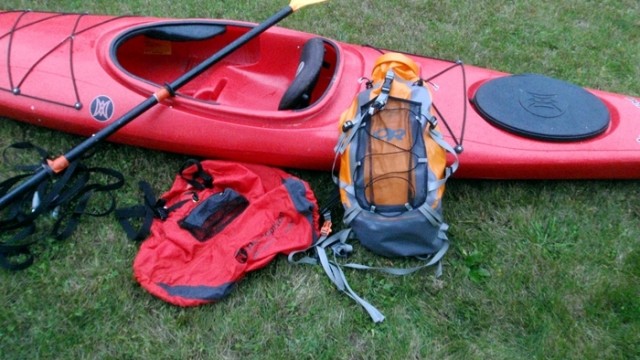There are times when even the best backpack just plain isn’t adequate. When things get REALLY wet, they all leak. Waterproof fabric . . . hidden zippers . . . it just doesn’t matter; when the wind is blowing rain sideways, or when you tip over your kayak, things inside most backpacks get wet.
That’s not always a big deal. Your eating gear gets wet…no biggie. Your book gets wet…irritating, but not the end of the world. Your sleeping bag gets wet . . . THAT can be pure misery, or even severe danger. And, in the wonderful modern world where we have to stay connected even while in the woods (yes, I’m guilty of that; if I couldn’t stay connected, I couldn’t get as much time outdoors. Tradeoffs…), getting your computer or cell phone wet can be VERY expensive.
One solution, of course, is small dry bags inside your main pack. We use that method regularly, and it’s highly effective. But drybags inside a daypack can waste otherwise usable space, they add some weight, and they are often a pain in the butt. Is there another solution for day hiking?
Yes, and it’s the Outdoor Research DryComp Ridge Sack. The most elaborate of OR’s waterproof packs, this surprisingly full-featured 34L (2075 cubic inch) drybag fits multiple niches. OR pitches it as a peakbagger’s dream, and it certainly works for that…but how many people really do that kind of hiking? There are plenty of other uses for it for “regular” people.

What makes this different from just being a drybag with shoulder straps? Well, start with the mesh sleeve at the back. Depending on your needs for a given trip, you can put anything in there from a hydration bladder to your lunch. Not raining when you head out, but threatening? Stuff your raingear in there, and you won’t have to risk getting other items wet by opening the pack.
Also, compression straps allow you to shrink the bag front-to-back, pulling the load to your center of gravity. With a pack this size, you can stuff a fair amount of weight inside, so having the load stable and tight to you is important if you’re scrambling your way to the top. Ice axe loops with shockcord keepers can, of course, hold ice axes, or your trekking poles or other long items. A zigzag shockcord across the back of the mesh sleeve can also hold rainwear, or any other clothing you shed during your hike.
Over the summer, this pack was a favorite whenever we were kayaking or canoeing. We’d stuff our valuables inside, then make sure there was plenty of air left in when we sealed it; not only did we not have to worry about things getting wet, we also didn’t have to worry about it sinking. It was just the right size, too; big enough to carry a fair amount, but small enough to shove in front of my feet in the kayak. Salt water, of course, is deadly to electronics… when I got it good and soaked, I simply took a hose to it before opening it to make sure that none of the the salt got where I didn’t want it.

It’s also become a favorite for short hikes with camera gear. New England is famous for random “rain events” when blue skies are forecast; I wish I could count the times I’ve gotten wet when the sky was clear blue 15 minutes earlier. While most of our photography is done with Olympus waterproof cameras, there are times when I want/need the flexibility of my Sony Alpha 100 with multiple lenses, more powerful flash, etc. Get that stuff soaked, and it’s trouble. Into the OR bag it goes with a little padding, and I know it’s safe. If I want to immediately download to my laptop and edit on the spot so that I know that I have the photos that I need, there’s plenty of room in the Ridge Sack for that, as well.
And, of course, there’s just having it sitting in my trunk along with my boots and trekking poles for those times that I have some spare time to go check out a different trail or just get out into the woods for an impromptu picnic lunch. In goes whatever I need, no worries involved. No, it’s not as comfortable or stable as something like my Osprey Raptor 14, but it’s light (just over a pound), rolls up small in my trunk, and works in ANY weather.
In a pinch, if I needed to carry a bunch of water back to a camp, I could reverse its intended use and pretend it’s an MSR Dromedary with straps (Warning: OR says the plastic is NOT officially food-grade, so we can’t recommend doing that with drinking water).

Nothing’s perfect, and I do have two nitpicks. First, there’s no grab handle at the top of the bag. In theory you could grab where the buckle snaps the roll top together, but I’m against that; if that buckle gets broken, it’s no longer a drybag. The grab handle is a small feature, but a nice one to have. Second, a bag with this much internal volume should have a better hipbelt. It’s easy to throw a fair amount of weight inside, and the little strap they provide isn’t really adequate. The shoulder straps are much better; if they put 8″ of that material on either side of the pack, then added the straps, it’d sit on your hips a whole lot better and add virtually nothing in weight. Hmmm…maybe it’s time for another of my infamous “Frankenstein” projects!
Bottom line…like everything we’ve ever tried from Outdoor Research, this is a carefully thought out, solidly built product that bridges some distinct gaps in our other gear. It’s well worth your consideration if you tend to have valuable items that you need protected from unexpected (or, as often happens in our case, uncoordinated) wet situations.


